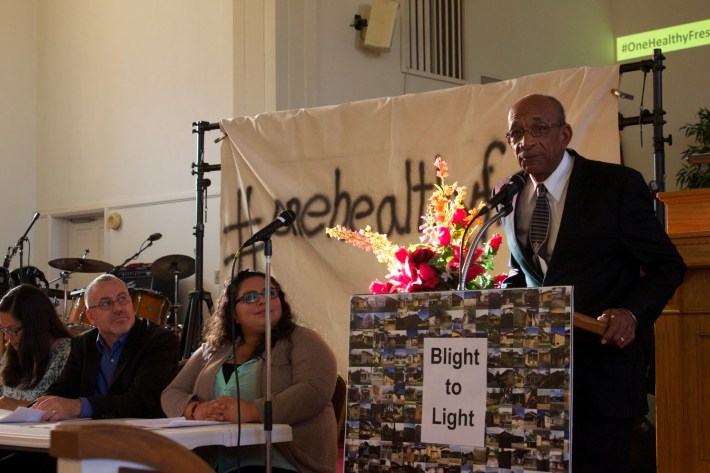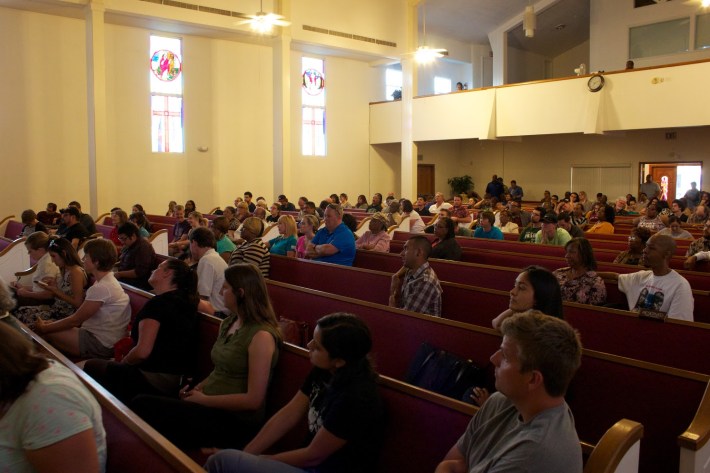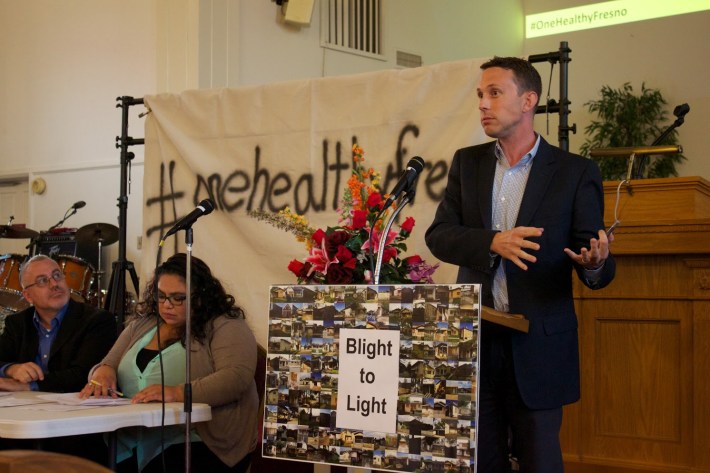
“It’s morally right to correct the blight in this community,” said pastor Richard Daniels, who leads the Baptist Fellowship church, as he introduced the evening’s program.
The Blight to Light community action meeting aimed to bring community members, faith leaders, and city officials together to address the current city ordinance that deals with boarded-up homes, dilapidated properties, and substandard living conditions inflicted by slumlords. Over 100 residents attended last night's meeting.
The coalition of community benefit organizations behind Blight to Light have five key recommendations for the review of the city ordinance plan that they believe will bring significant change to many neighborhoods and communities around Fresno.
The recommendations include a fee for property owners who leave homes vacant for more than 60 days; mandated inspection and approval from the city before tenants are allowed to move in; transparency and clearer language in code development that includes a continual report from the city attorney on properties that are improved; an inclusion of a private attorney clause which would allow community-benefit organizations to coordinate legal action if the city fails to uphold its own codes; and allowing tenants who occupy substandard living conditions to be formally included in phase 2 of a city task force created to study the city's blight policies.
Most of these recommendations are utilized in neighboring cities, such as Selma, which is also in Fresno County. The recommendation concerning coordinated legal action actually already exists in a separate part of the city code.
“Fresno does not have an effective system for documenting, tracking, monitoring, and eliminating vacant properties,” said Janei Nkosi, a Faith in Community member and humanities professor at Fresno State, who has been researching the blight problem in Fresno with students and community leaders.
Fresno Mayor Ashley Swearengin recently created the aforementioned “task force,” which is comprised of city council members and community leaders and assigned the task of revising the city of Fresno blight ordinance. Councilmember Clint Olivier of District 7, who was present last night, is on the task force.
“The city government has a larger role to play in this solution,” said Olivier. “We want to beef up our code enforcement and we want to go out and we want to crack heads,” he added.
However, when directly asked if he would support the recommendations presented, Olivier said he would only support one of the changes, which was to allow tenants who occupy substandard living conditions to be formally included in phase 2 of the task force.
Nkosi says the potential policy changes that could occur with an updated blight ordinance could be the landmark that has been in the making for decades. She mentioned that Martin Luther King came to Fresno in 1963 to talk about this same issue.
“After our city council presides over this, we want to see a historic headline in The Fresno Bee,” said Nkosi.
Nkosi said her research determined that there are over 10,000 vacant properties in Fresno, and this is a burden not only to the communities affected, but all taxpayers. In 2014 alone, there were 90 vacant property fires, which Nkosi says cost taxpayers $200,000 to $500,000.
Blight to Light will lead up to Thursday April 29, when the task force is to meet to review the city ordinance.
Several residents gave community testimonies, explaining their personal experience in living in blighted homes and substandard living conditions inflicted by property owners. Jose Lopez, a Fresno City College student, detailed his experience.
“This isn’t a problem for an individual or to an individual community,” said Lopez, “For over 10 years my family and I have lived under theses conditions,” he added.
Lopez described moldy, inoperable refrigerators, toilets without proper plumbing, and no heat.
“These are real problems. They require real solutions. They require courage from our city leaders,” he added.







